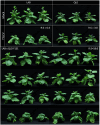Exploring the source of TYLCV resistance in Nicotiana benthamiana
- PMID: 38863537
- PMCID: PMC11165019
- DOI: 10.3389/fpls.2024.1404160
Exploring the source of TYLCV resistance in Nicotiana benthamiana
Abstract
Tomato Yellow Leaf Curl Virus (TYLCV) is one of the most devastating pathogens of tomato, worldwide. It is vectored by the globally prevalent whitefly, Bemisia tabaci, and is asymptomatic in a wide range of plant species that act as a virus reservoir. The most successful crop protection for tomato in the field has been from resistance genes, of which five loci have been introgressed fromwild relatives. Of these, the Ty-1/Ty-3 locus, which encodes an RNA-dependent RNA polymerase 3 (RDR3), has been the most effective. Nevertheless, several TYLCV strains that break this resistance are beginning to emerge, increasing the need for new sources of resistance. Here we use segregation analysis and CRISPR-mediated gene dysfunctionalisation to dissect the differential response of two isolates of Nicotiana benthamiana to TYLCV infection. Our study indicates the presence of a novel non-RDR3, but yet to be identified, TYLCV resistance gene in a wild accession of N. benthamiana. This gene has the potential to be incorporated into tomatoes.
Keywords: Nicotiana benthamiana; RNA-dependent RNA polymerase; Ty genes; disease resistance; tomato yellow leaf curl virus.
Copyright © 2024 Hayashi, Souvan, Bally, de Felippes and Waterhouse.
Conflict of interest statement
The authors declare that the research was conducted in the absence of any commercial or financial relationships that could be construed as a potential conflict of interest. The author(s) declared that they were an editorial board member of Frontiers, at the time of submission. This had no impact on the peer review process and the final decision.
Figures







Similar articles
-
Crinivirus Tomato Chlorosis Virus Compromises the Control of Tomato Yellow Leaf Curl Virus in Tomato Plants by the Ty-1 Gene.Phytopathology. 2023 Jul;113(7):1347-1359. doi: 10.1094/PHYTO-09-22-0334-R. Epub 2023 Aug 29. Phytopathology. 2023. PMID: 36690608
-
Post-transcriptional gene silencing in controlling viruses of the Tomato yellow leaf curl virus complex.Arch Virol. 2006 Dec;151(12):2349-63. doi: 10.1007/s00705-006-0819-7. Epub 2006 Jul 27. Arch Virol. 2006. PMID: 16862387
-
The NLR Protein Encoded by the Resistance Gene Ty-2 Is Triggered by the Replication-Associated Protein Rep/C1 of Tomato Yellow Leaf Curl Virus.Front Plant Sci. 2020 Sep 10;11:545306. doi: 10.3389/fpls.2020.545306. eCollection 2020. Front Plant Sci. 2020. PMID: 33013967 Free PMC article.
-
Natural resistance of tomato plants to Tomato yellow leaf curl virus.Front Plant Sci. 2022 Dec 19;13:1081549. doi: 10.3389/fpls.2022.1081549. eCollection 2022. Front Plant Sci. 2022. PMID: 36600922 Free PMC article. Review.
-
The Global Dimension of Tomato Yellow Leaf Curl Disease: Current Status and Breeding Perspectives.Microorganisms. 2021 Apr 1;9(4):740. doi: 10.3390/microorganisms9040740. Microorganisms. 2021. PMID: 33916319 Free PMC article. Review.
Cited by
-
How Helpful May Be a CRISPR/Cas-Based System for Food Traceability?Foods. 2024 Oct 25;13(21):3397. doi: 10.3390/foods13213397. Foods. 2024. PMID: 39517184 Free PMC article. Review.
References
-
- Belabess Z., Dallot S., El-Montaser S., Granier M., Majde M., Tahiri A., et al. . (2015). Monitoring the dynamics of emergence of a non-canonical recombinant of Tomato yellow leaf curl virus and displacement of its parental viruses in tomato. Virology 486, 291–306. doi: 10.1016/j.virol.2015.09.011 - DOI - PubMed
-
- Butterbach P., Verlaan M. G., Dullemans A., Lohuis D., Visser R. G. F., Bai Y., et al. . (2014). Tomato yellow leaf curl virus resistance by Ty-1 involves increased cytosine methylation of viral genomes and is compromised by cucumber mosaic virus infection. Proc. Natl. Acad. Sci. U.S.A. 111, 12942–12947. doi: 10.1073/pnas.1400894111 - DOI - PMC - PubMed
LinkOut - more resources
Full Text Sources

